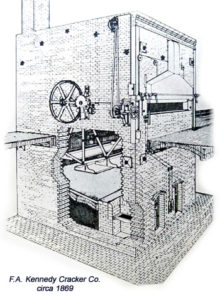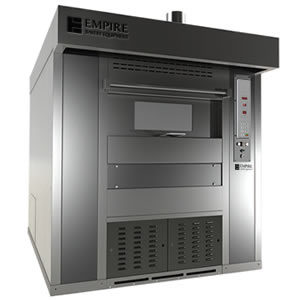From Humble Beginnings: The Revolving Oven Evolved
When baking is your livelihood, a quality oven is the key element in your success. Since its introduction more than 150 years ago, the Revolving Oven - also known as the Reel Oven - has gained worldwide popularity in Bakeries, Supermarkets, Patisseries and Bagel Shops of all sizes. Versatile and reliable, Revolving Ovens are ideal for a wide range of products from breads, bagels and sweet goods to pizza, meats and so much more. If you're in the market for a new oven, then a Revolving Oven may be just what you're looking for!
In The Beginning

The first Revolving Ovens began showing up in the 1850s. Widely acknowledged as the earliest mechanical ovens in the U.S., the invention of the Revolving Oven is credited to Hosea Ball. However, it was the adoption of Ball's design into the growing cracker industry of the time that truly helped the Revolving Oven take root. E.O. Brinckerhoff Ship Bread & Cracker Co. in NY was one of the first to take advantage of Ball's design. A few years later, Frank Kennedy of the F.A. Kennedy Cracker Co. in Cambridge, MA, installed several Revolving Ovens, helping to increase his production tenfold.
Truly innovative for their time, the original Revolving Ovens were very basic in design. Instead of one baking surface, as in the standard tile oven of the era, the Revolving Oven featured 8-12 long iron shelves arranged around the circumference of a large drum. Mounted on a large shaft and driven by an external motor, this drum rotated through the baking chamber like a carousel. The heat source, most commonly coal or wood, was located at the bottom of the chamber. After the turn of the century, natural gas began replacing coal and wood as the primary fuel source and insulated steel baking chambers became common. The addition of steam to the baking process was also possible through the use of an external steam boiler. The Revolving Oven quickly established itself as a versatile and reliable option in a growing industry.
Today's Revolving Ovens
Fast forward 150 years and we find the Revolving Oven is still a staple in Bakeries, Bagel Shops, Pizzerias, Patisseries and Supermarkets all around the world. Notably, the fundamental design principles remain the same but modern Revolving Ovens are indeed an evolution of Ball's design. Let's take a look at some of the key features of today's Revolving Ovens. Today, we currently find ourselves in yet another bagel boom, similar to the one we saw in the 1990s. We are seeing bagel shops popping up everywhere and existing bagel shops reinventing themselves and offering new innovative products. Amongst the boom and the evolution of bagel products, there is one thing that still stays the same: the Revolving Oven is the go-to oven for bagel baking.
Compact Size
Revolving Ovens were traditionally large, heavy, blocky pieces of equipment. Today's Revolving Ovens are smaller and more compact than ever. By stacking the shelves two high around the carousel instead of one, you're able to bake the same amount of product in half the space. Superior insulation has helped minimize the baking chamber structure and compact burner technology allows you to experience significant fuel-saving benefits while also helping to minimize the oven's overall footprint.
Self-Generating Steam
External steam boilers are extremely inefficient. Not only do they require additional resources to heat and maintain, but significant steam and water loss is experienced as the steam moves from the boiler to the heating chamber. Modern Revolving Ovens feature integrated steam systems whereby the generator is housed inside the baking chamber. The same energy that's being used in the chamber to bake is used to generate the steam, and since it doesn't need to travel to get to the baking chamber, there is no loss of water or energy. The availability of steam in these ovens is also what makes them a coveted oven for bagel shops. The signature shiny shell of a fresh bagel that keeps the customers coming back for more is due to sufficient steam during the baking process.
Energy Efficiency
As previously mentioned, today's Revolving Ovens utilize modern oven burner technology to cut fuel costs. As an example, Empire's Revolving Oven's features a low-maintenance burner system. A clean, quiet, direct flame burner with exceptional stability, the Empire LC's burner system automatically adjusts the flame to maintain a constant temperature within the baking chamber. In addition, the gentle air circulation system gently directs the flow of air inside the chamber, allowing it to heat evenly and more efficiently. These systems work together harmoniously to bake evenly, consistently and to minimize unnecessary fuel usage.

Programmable Controls
Traditional Revolving Ovens relied on bakers with years of experience to control oven temperature, baking times and product quality. Modern Programmable Controls make today's ovens extremely easy to use helping you keep training time to a minimum. Simply load the product and press a button to start the baking cycle. Today's panels are highly visible and easy to control - even when wearing an oven glove.
Product Versatility
Today's Revolving Ovens can be outfitted in a variety of ways, giving you maximum product versatility. Traditional steel shelves can be used for pastries, cookies, cakes and meats (to name just a few), while stone-lined shelves are perfect for hearth products like breads, pizzas, bagels and more. The optional steam system is a great addition for the Artisan baker and because there are multiple shelves and lots of room to go around, you can bake a variety of different products all at the same time!
Thanks to advancements in technology and design, today's Revolving Ovens are among the most economical baking solutions available. Multiple baking shelves provide increased productivity while the compact design eats up less valuable space in your bakery. Highly energy efficient and extremely versatile, the Revolving Ovens provide even, consistent baking, making it an excellent choice for so many bakers.
If you have questions or simply want to learn more about how a Revolving Oven can benefit you, talk to a qualified equipment representative today. After all, baking is the final testament to your art, and you deserve the very best!

